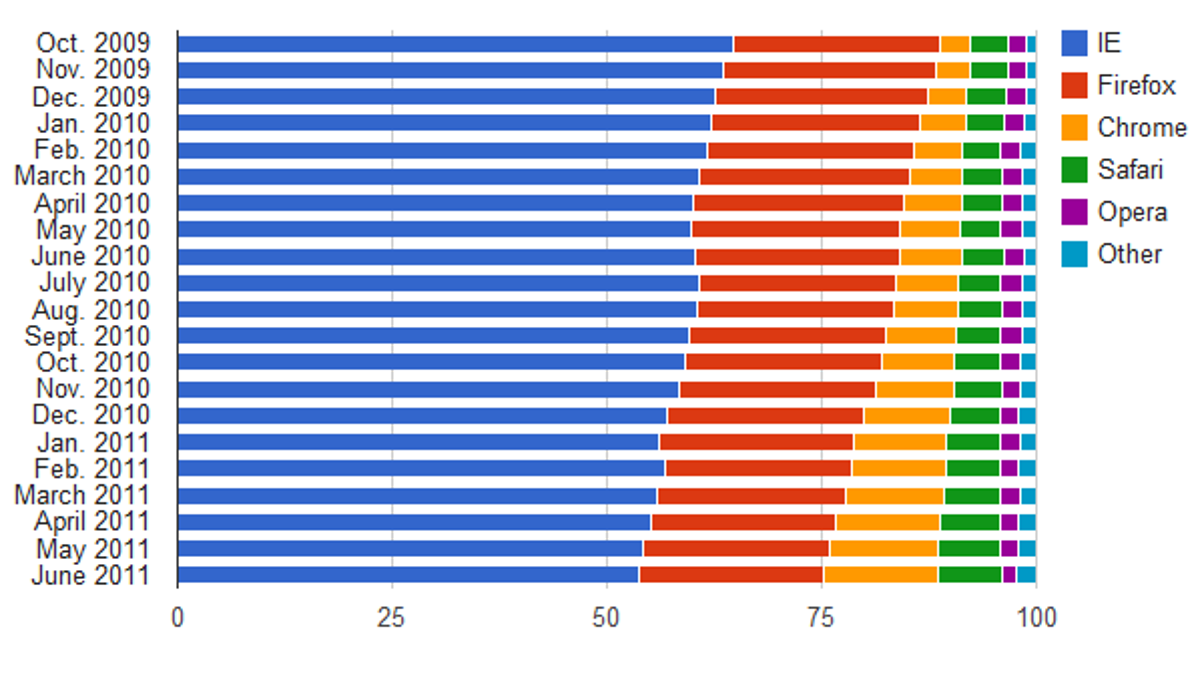Chrome rises at IE's expense; iPad makes a showing
The ascent of Google's browser takes another notch out of IE's overall usage in June, though IE9 is growing. Mobile browsing is hot, now surpassing 5 percent of usage worldwide.

Prevailing trends in the rising and falling fortunes of Web browsers continued through June, with Apple's iPad carving out a sizable slice of usage.
Google's Chrome continued its ascent of usage, rising from 12.5 percent in May to 13.1 percent in June, according to Net Applications' monthly tallies. Microsoft's Internet Explorer dropped about the same amount, from 54.3 percent to 53.7 percent.
Second-place Firefox, from the non-profit Mozilla organization, continued to tread water, staying at 21.7 percent. Apple's Safari ticked up from 7.3 percent to 7.5 percent, but Opera dropped from 2 percent to 1.7 percent.
Apple is a rising force in mobile browsing. Its iPad surpassed 1 percent of browser usage worldwide, Net Applications said.
Related links:
• Rapid-release Firefox meets corporate backlash
• IE9: Microsoft is back in the browser game
• Chrome's security overhaul begins with PDF plug-in
Globally, mobile phones and tablets surpassed 5 percent of browser usage. In the United States, it's 8.2 percent. There, the iPhone leads with 2.9 percent, Android phones have 2.6 percent, the iPad 2.1 percent, and BlackBerry phones 0.6 percent.
Fractions of a percent are small, but given how many millions of people use the Web, each tenth of a percent represents a vast number of people in absolute terms.
New versions are important for Microsoft and Mozilla in particular. The new Firefox 5, the first issued under a new and somewhat controversial rapid-release program, represented 2.1 percent of usage overall to 10.5 percent for Firefox 4. Although Mozilla is being more aggressive about automatically updating people to the latest browser, Firefox 5 has only been out for a week and a half.
Microsoft's Internet Explorer 9, released in March, climbed from 4.2 percent in May to 5.7 percent in June, a slower pace than before.
Microsoft prefers to look at its Windows 7 share of IE9 rather than the global share, since it considers Windows 7 a leading indicator of future trends. That's true, though Web developers must reckon with the doggy older browsers, too--IE9 won't run on Windows XP, which is still the most widely used operating system on the Web today. On Windows 7, though, IE9 achieved 21.8 percent share of usage in the United States and 15.6 percent globally.
Microsoft is ramping up its efforts to squeeze IE6--despised by Web developers--off the Net.
"The positive momentum in moving the world to a modern browser continues this month with IE6 and IE7 dropping a combined 0.8% share worldwide for the month of June," said Roger Capriotti director of Internet Explorer product marketing, in a blog post today. "We also have expanded our IE6 Countdown efforts with two more global sites going live this month. China, which represents the largest portion of IE6 share worldwide has launched a local site, and our team in Latin America has also released a local version of IE6 Countdown to help get people there to move to a modern browser."
Updated at 3:51 a.m. PT with details about iPad and mobile browsing and other specifics.

